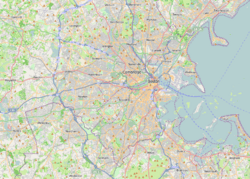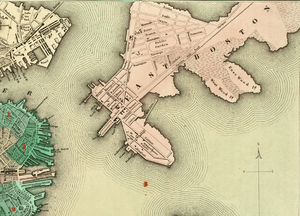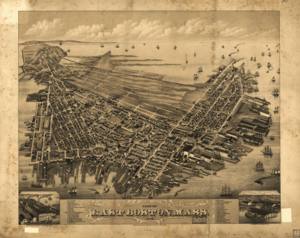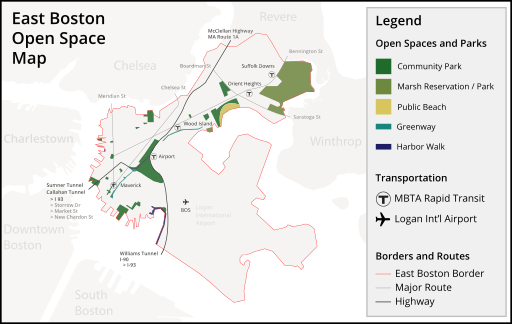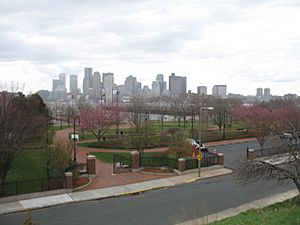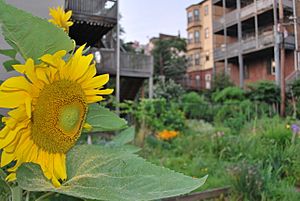East Boston facts for kids
Quick facts for kids
East Boston
|
||
|---|---|---|
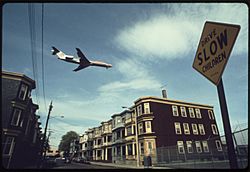
An airplane approaching Logan International Airport in 1973
|
||
|
||
| Nicknames:
Eastie
|
||

Neighborhood map of East Boston, Massachusetts
|
||
| Country | United States | |
| State | Massachusetts | |
| County | Suffolk | |
| Neighborhood of | Boston | |
| Annexed by Boston | 1637 | |
| Area | ||
| • Land | 4.7 sq mi (12 km2) | |
| Population
(2010)
|
40,508 | |
| • Density | 8,618/sq mi (3,327/km2) | |
| Time zone | UTC-5 (Eastern) | |
| Zip Code |
02128, 02228
|
|
| Area code(s) | 617 / 857 | |
East Boston, nicknamed Eastie, is a neighborhood of Boston, Massachusetts, United States, which was annexed by the city of Boston in 1637. Neighboring communities include Winthrop, Revere, and Chelsea. It is separated from the Boston neighborhood of Charlestown and downtown Boston by Boston Harbor. The footprint of the East Boston neighborhood as it is known today was created in the 1940s by connecting five of the inner harbor islands using land fill. Logan International Airport is located in East Boston, connecting Boston to domestic and international locations.
East Boston has long provided homes for immigrants with Irish, Russian Jews and later, Italians. John F. Kennedy's great-grandfather was one of many Irish people to immigrate to East Boston, and the Kennedy family lived there for some time. From 1920 to 1954, East Boston was the site of the East Boston Immigration Station, which served as the regional immigration hub for Boston and the surrounding area. A once Italian dominated community, East Boston has demographically changed to reflect a diverse population of immigrants. After the 1990s, the neighborhood witnessed growing numbers of Latin American immigrants, who have come to make up over fifty percent of the population according to the 2020 Census data.
History
The landmass that is East Boston today originally comprised five islands sited east of the confluence of the Malden, Mystic, and Charles rivers, and across the harbor from the westerly city of Boston. These islands included: Noddle's; Hog's; Governor's; Bird; and Apple. The town of East Boston was first developed on the largest of these, Noddle's, a noted source of timber and grazing land, used for farming by English colonists throughout the eighteenth century.
Early development of the city
Sumner and Noddle's Island
As early as 1801, William H. Sumner, who had inherited a large tract on Noddle's Island, proposed that the federal government of the United States create a turnpike to connect Massachusett's North Shore (along with Sumner's property on Noddle's) to Boston, arguing that such a road would create a valuable, direct route across Boston's harbor, making it easier for Boston, at the time an isolated peninsula surrounded by water, to expand: "There is no doubt but that the necessities of the town of Boston will some time require a connection with Noddle's Island." When this plan was rejected in favor of a route through Chelsea (a route, not coincidentally, that left the Boston navy yard in nearby Charlestown with ocean access), Sumner moved onto other plans to improve Noddle's value.
By 1833, Sumner, with partners Steven White and Francis J. Oliver, had bought up half of Noddle's acreage. Together, they founded the East Boston Company, and continued to consolidate additional landholdings. By 1834, the East Boston Company had complete control over the island. The company's purpose was to own and develop the land and call it East Boston. In anticipation of population growth, the proprietors adopted a grid street plan, the first planned neighborhood in the city of Boston. Jeffries Point, located at the southern end of the peninsula that faced Boston, was the earliest area of East Boston to be settled.
A bridge to Chelsea was built, roads were laid out, and houses were built. Much of this activity was spurred by the formation of the East Boston Lumber Company. During this period, the Boston Sugar Refinery was also founded, which was the first manufacturing establishment in East Boston. They are credited for the creation of white granulated sugar.
The Boston Shipyards and Donald McKay
By 1835, ten wharves had been built. The abundance of wharf area opened the new East Boston to further rapid expansion, and it was the shipbuilding companies that soon became East Boston's most famous industry, and the mainstay of its economy. In 1836, as development began to totally change the former islands, East Boston was annexed to Boston.
In 1845, Donald McKay, as a sole owner, established his own shipyard on Border Street. His ships included the Flying Cloud (1851), which made two 89-day passages from New York to San Francisco and the Sovereign of the Seas (1852), which posted the fastest speed ever by a sailing ship (22 knots) in 1854.
In the 1840s and 1850s, the principal shipbuilders besides McKay included Paul Curtis and Samuel Hall. In addition, Sylvanus Smith became a noted shipbuilder in East Boston.
Connections to the mainland
In the 1830s, the largest problem keeping East Boston from thriving was transportation. The East Boston Company believed the neighborhood could not become a valuable asset until people had a way to reach the area from the Boston mainland. As a temporary solution, they set up a paddle steamer to carry 15 people at a time from Boston Proper to the neighborhood. It was used primarily for occasional visits from public officials and laborers. Though they did not have the ridership to support additional boats, the company purchased the Tom Thumb steamboat.
The steam railroad system was still in its infancy at this point, and the East Boston Company was approached by an inventor of a new type of rail system, the suspension railway. This system was one of the earliest suspended railroads to be built. The railroad cars were propelled by a steam engine hanging from a suspended track. Henry Sargent, the inventor, stated "that his invention would make the Island a center of attraction to many people." The Company allowed it to be built on its land and it was in use for nine days in 1834, then closed citing lack of ridership.
In the mid-1830s, the Company made several investments to further East Boston's development. They continued attempts to get the Eastern Railroad to come to East Boston. The Maverick and East Boston ferries began service from Lewis Wharf on the mainland to East Boston.
The ferry service from Noddle's Island was replaced in 1904 by the streetcar tunnel that became the MBTA Blue Line, the first underwater tunnel in North America.
Boston's "Ellis Island"
Since the mid-19th century, the community served as a foothold for immigrants to the United States: Irish and Canadians came first, followed by Russian Jews and Italians, then Southeast Asians, and, more recently, an influx from Central and South American countries. The Orient Heights section of East Boston was the first area in Massachusetts to which Italians immigrated in the 1860s and 1870s, and today the heart of the Italian community remains in East Boston. The Madonna Shrine, which is the national headquarters of the Don Orione order, sits on top of the Heights and is a replica of the original religious structure in Rome. In the 1880s, the Immigrants House operated in East Boston to help immigrants during their arrivals with economic support and social services. The building in which the Immigrants House operated was later named Landfall and served as the first senior citizen housing in the community.
During World War I, areas of East Boston served as an internment camp for Germans taken off of ships. Period images show small unfenced buildings and tiny gardens built by the internees, leading right up to the water's edge. In 1919, moves were undertaken to formalize these facilities. Originally officials planned to use one of the Harbor Islands to replace their rented quarters on Long Wharf, but this plan was abandoned for a site on Marginal Street, directly on the East Boston wharves. Construction began in late 1919 on the East Boston Immigration Station, which served as Boston's first purpose-built immigration station. The East Boston Immigration Station operated from 1920 to 1954 as the region's immigration hub. In 2011, the Immigration Station was torn down.
Unlike Ellis Island in New York, inspectors at the East Boston station processed immigrants at steamship docks, only transferring to the immigration station problem cases who had issues with their paperwork or required a secondary interview. Opposite the station, steps leading to East Boston were called the 'Golden Stairs' "because they represented the final climb to golden opportunity in America for countless Europeans." The station operated from 1920 to 1954 as the region's immigration hub.
The population of East Boston, which was recorded as a mere thousand in 1837, exploded to a high of just over 64,000, according to the 1925 census. The sudden rise is attributed to the immigrants who came from Southern Italy. Today, the neighborhood is home to over 40,000 inhabitants, with a median income per household of around $46,000.
Kennedy family
When my great grandfather left here to become a cooper in East Boston, he carried nothing with him except two things: a strong religious faith and a strong desire for liberty. I am glad to say that all of his great grandchildren have valued that inheritance.
The Kennedy Family lived on Meridian Street in what is now a small home wedged between a Hispanic market and hardware store, approaching the Meridian Street branch of the Boston Public Library. The family later moved to a larger home on Monmouth Street. P. J. Kennedy's success enabled him to purchase a home for his son, Joseph, and another for his two daughters at Jeffries Point.
In 1954, John F. Kennedy famously paraded through East Boston with his wife, Jackie, in anticipation for his campaign to run for United States Senate, to secure votes from the neighborhood. In a famous photograph, Kennedy is shown walking down Chelsea Street heading towards Maverick Square, waving to the crowd in front of Santarpio's Pizza.
On numerous occasions throughout his career in the United States Senate, Senator Ted Kennedy mentioned that his family's roots are embedded in East Boston.
Geography
Maps
Sites of interest
Parks
- Belle Isle Marsh Reservation – The largest remaining salt marsh in Boston. It is a reserve for a variety of flora and fauna.
- Constitution Beach – Public beach in East Boston's Orient Heights neighborhood.
- Golden Stairs Terrace Park – Historic site immigration site, outdoor staircase from the former Boston Immigration center landing into East Boston; symbolically "the golden steps into opportunity," and the United States. Now a small public park.
- Piers Park – Public park constructed on top of an original 1870 seawall and pier, it includes a meandering brick pedestrian promenade and four shade pavilions, and the Piers Park Sailing Center. As of October 2022, Phase Two of the park's development by the Massachusetts Port Authority was expected to end in 2023. Phase Three, announced in 2020, is under the oversight of The Trustees of Reservations.
Community gardens
- Bremen Street Community Garden – The garden is located in the Bremen Street Park, that the Massachusetts Port Authority owns and operates. The garden is run by garden coordinators.
- Eagle Hill Community Garden sunflower blooming in the Eagle Hill Memorial Community Garden on Border Street. — The Trustees of Reservations maintains the garden in collaboration with residents.
- EBNHC Wellness Garden – The East Boston Neighborhood Health Center operates the garden to promote healthier lifestyles by giving garden plots to patients and Let's Get Movin' participants.
- Joe Ciampa Garden – The Trustees of Reservations maintains the garden in collaboration with residents.
- "Nuestro Jardín" ("Our Garden") – sited across from the Umana School, was formerly reserved for use by schoolchildren, but is now maintained by a community-based youth program and Eastie Farm, a non-profit that works in addressing the effects of food insecurity and climate change in East Boston.
Places of worship (past and present)
Source:
- Maverick Congregational Church – Formerly named the First Congregational Church; East Boston's first place of worship.
- Church of the Most Holy Redeemer – The first Roman Catholic church in East Boston.
- Our Lady of the Assumption Church
- Saratoga Street Methodist Episcopal Church – As of 2022, the church's location is the Central Park Lanes Bowling Center.
- First Presbyterian Church – In 1996, the church closed down but since the 2000s two other congregations gather there; Iglesias del Dios Vivo and La Luz del Mundo.
- Church of the Sacred Heart
- Maverick Congregational Church
- St. John's Episcopal Church – Wallis Howe from Martin and Hall Architects built the church in 1903 and since the 2000s, the East Boston APAC Headstart has operated there.
- Church of Our Father – Organized in 1845, this was the only Unitarian church in the neighborhood. In 1900, the church was sold and moved; the East Boston Post Office is located in the former building.
- Temple Ohel Jaocob – Founded in 1893 as the first place of worship for the Jewish community, this was the neighborhood's oldest and longest synagogue.
- Church of St. Mary Star
- Our Lady of Mount Carmel – Italian immigrants built the church in 1907, and in 2004 the Archdiocese of Boston closed the church.
Church at the Well - meeting inside The Well Coffee House on Border st.
Historic
Businesses
- Santarpio's Pizza – one of the original pizzerias that catered to Italian Americans who had emigrated to East Boston and the surrounding neighborhoods.
Neighborhoods
- Central Square
- Day Square
- Eagle Hill
- Maverick Square
- Orient Heights
Places
East Boston has eight places on the National Register of Historic Places:
- Baker Congregational Church
- Barnes School
- Bennington Street Burying Ground
- Eagle Hill Historic District
- Donald McKay House
- United States lightship Nantucket (LV-112)
- Temple Ohabei Shalom Cemetery
- Trinity Neighborhood House
Sports arenas and stadiums
- Suffolk Downs – defunct as of 2017
- East Boston Memorial Stadium – Since 2015, Suffolk University has used the stadium for their baseball, soccer, and softball teams to practice and play games. The stadium belongs to the City of Boston and serves multiple purposes for the community. East Boston High School also utilizes the stadium annually to hold their graduation ceremony.
East Boston Celebrations
East Boston has two annual recurring celebrations take place every summer. Eastie Week takes place for two weeks every July in collaboration between Boston Harbor Now and local partner organizations. During the celebrations, the organizations offer free and affordable events for families in East Boston. Eastie Pride Day is a long-standing celebration founded by former City Councilor Sal LaMattina that takes place at Piers Park. The celebration is open and free to the public and offers food, music, kids games, and community resources.
Transportation
Transportation has long played a role in the shaping of East Boston. Clipper ships were built at the shipyard owned by Donald McKay in the mid-19th century. A subway tunnel connecting the neighborhood to the rest of the city opened in 1904 and was the first undersea tunnel of its kind in the United States. Rows of houses were torn down to build the Sumner Tunnel in 1934 and the Callahan Tunnel in 1961, directly connecting automobile traffic from downtown Boston. In the early 1920s, an airfield was built, and eventually it was expanded to become Logan International Airport. The eastern terminus of Interstate 90 (the Massachusetts Turnpike) has been at Route 1A next to Logan Airport since 2003, and the newer Ted Williams Tunnel (1995) links I-90 from East Boston to the rest of the city.
Logan International Airport
Logan Airport, New England's primary international airport and 48th busiest in the world, resides mainly in East Boston (though part of the airfield itself lies in Winthrop). There has been continual controversy surrounding Logan, as constant conflict with the Massachusetts Port Authority has been a source of bitterness among some local residents since its inception. One expansion of the Airport resulted in the loss of Wood Island Park, a green space designed by the noted landscape architect Frederick Law Olmsted. The expansion of Logan Airport in the late 1960s and early 1970s displaced families along Neptune Road, which is now used for warehouses and rental car property. The airport has since implemented four "airport edge buffers," which include parks and greenery to appease residents.
The neighborhood is easily accessible to downtown Boston via the MBTA Blue Line, which stops at Maverick, Airport, Wood Island, Orient Heights, and Suffolk Downs in the East Boston area. Massport provides free shuttle buses from the Airport MBTA station to all Logan Airport terminals and the Rental Car Center. The East Boston Greenway, a shared use path and park along a former rail line, connects to the Airport station.
Notable people
- John L. Bates, 41st Governor of Massachusetts
- Benjamin A. Botkin, scholar and folklorist
- Filippo Buccola, gangster, boss of the Patriarca crime family
- Thomas J. Buckley, 18th Massachusetts Auditor
- John J. Douglass, member of the United States House of Representatives from 1925 to 1933
- Frank Greer, rower and Olympic gold medalist
- Helen Johns, swimmer and Olympic gold medalist
- P.J. Kennedy, Massachusetts politician and grandfather of U.S. President John F. Kennedy.
- Augie Lio, former American football player and member of the College Football Hall of Fame
- Frederick Mansfield, 46th Mayor of Boston
- Philip D. McNamara, Catholic priest
- William Matthew Prior, noted painter
- Gene Sharp, scholar
- Robert Travaglini, 93rd President of the Massachusetts Senate
- Jermaine Wiggins, former NFL player and Super Bowl XXXVI champion



